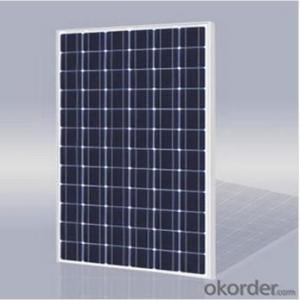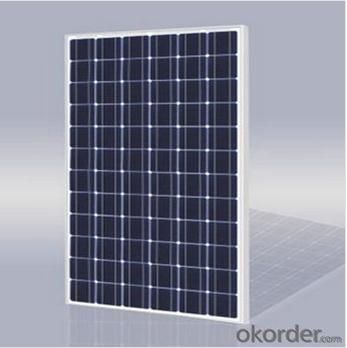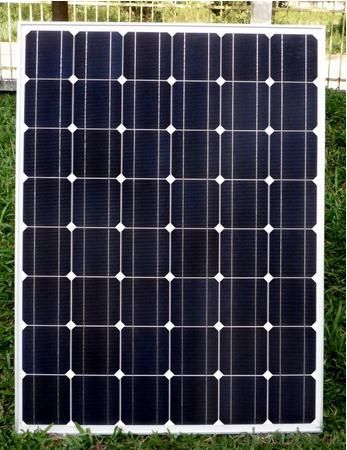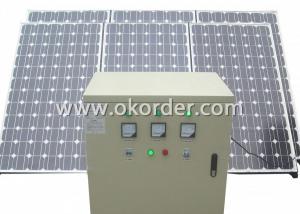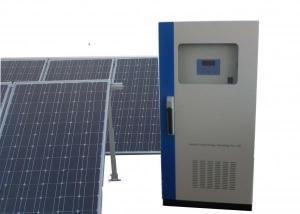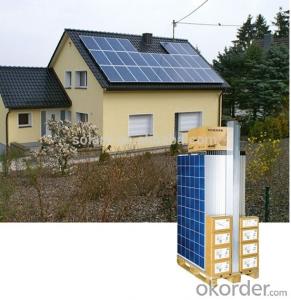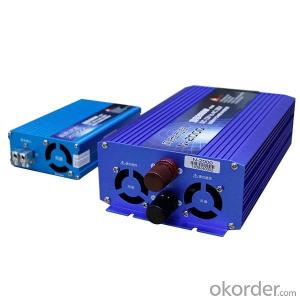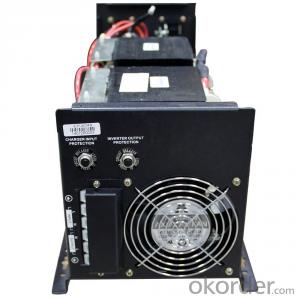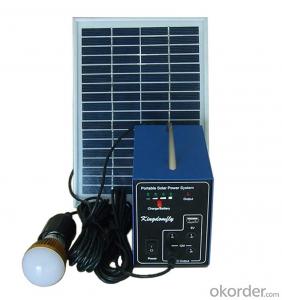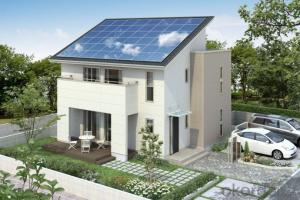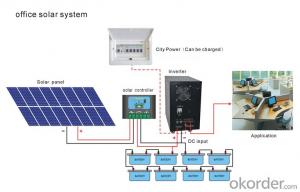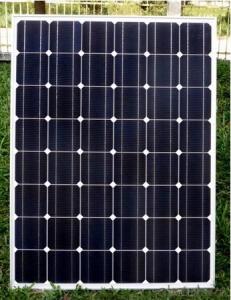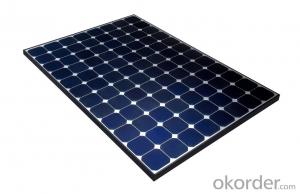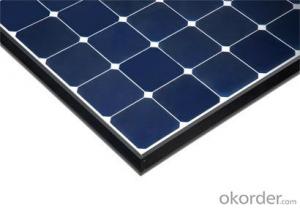Passive Solar Energy Systems CNBM On Grid System 7000W with Certificate UL TUV CE
- Loading Port:
- Shanghai
- Payment Terms:
- TT OR LC
- Min Order Qty:
- 100 watt
- Supply Capability:
- 1000 watt/month
OKorder Service Pledge
OKorder Financial Service
You Might Also Like
Specification
CNBM On Grid System 7000W with Certificate UL TUV CE
Product description
They range from small residential and commercial rooftop systems to large utility-scale solar power stations. Unlike stand-alone power systems, a grid-connected system rarely includes an integrated battery solution, as they are still very expensive. When conditions are right, the grid-connected PV system supplies the excess power, beyond consumption by the connected load, to the utility grid.
Connection of the photovoltaic power system can be done only through an interconnection agreement between the consumer and the utility company. The agreement details the various safety standards to be followed during the connection.[4]
Solar energy gathered by photovoltaic solar panels, intended for delivery to a power grid, must be conditioned, or processed for use, by a grid-connected inverter. Fundamentally, an inverter changes the DC input voltage from the PV to AC voltage for the grid. This inverter sits between the solar array and the grid, draws energy from each, and may be a large stand-alone unit or may be a collection of small inverters, each physically attached to individual solar panels. See AC Module. The inverter must monitor grid voltage, waveform, and frequency. One reason for monitoring is if the grid is dead or strays too far out of its nominal specifications, the inverter must not pass along any solar energy. An inverter connected to a malfunctioning power line will automatically disconnect in accordance with safety rules, for example UL1741, which vary by jurisdiction. Another reason for the inverter monitoring the grid is because for normal operation the inverter must synchronize with the grid waveform, and produce a voltage slightly higher than the grid itself, in order for energy to smoothly flow outward from the solar array.
Solar modules use light energy (photons) from the sun to generate electricity through the photovoltaic effect. The majority of modules use wafer-based crystalline silicon cells or thin-film cells based on cadmium telluride or silicon. The structural (load carrying) member of a module can either be the top layer or the back layer. Cells must also be protected from mechanical damage and moisture. Most solar modules are rigid, but semi-flexible ones are available, based on thin-film cells.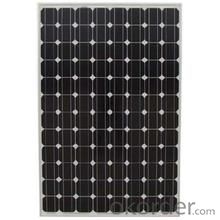
Application
Industrial
Commercial
Residential
Feature
Residential, grid-connected rooftop systems which have a capacity more than 10 kilowatts can meet the load of most consumers.[2] They can feed excess power to the grid where it is consumed by other users. The feedback is done through a meter to monitor power transferred. Photovoltaic wattage may be less than average consumption, in which case the consumer will continue to purchase grid energy, but a lesser amount than previously. If photovoltaic wattage substantially exceeds average consumption, the energy produced by the panels will be much in excess of the demand. In this case, the excess power can yield revenue by selling it to the grid. Depending on their agreement with their local grid energy company, the consumer only needs to pay the cost of electricity consumed less the value of electricity generated. This will be a negative number if more electricity is generated than consumed.[3] Additionally, in some cases, cash incentives are paid from the grid operator to the consumer.
Packaging
With carton and box
- Q: How do solar energy systems impact greenhouse gas emissions?
- Solar energy systems have a significant positive impact on greenhouse gas emissions as they generate electricity without producing any greenhouse gases during operation. By replacing traditional fossil fuel-based power sources, solar energy reduces the overall amount of greenhouse gases released into the atmosphere, thus helping mitigate climate change.
- Q: What are the advantages of using solar energy systems?
- There are several advantages of using solar energy systems. Firstly, solar energy is a renewable and abundant source of energy. It is derived directly from the sun, which means it will never run out. Secondly, solar energy systems are environmentally friendly as they produce zero greenhouse gas emissions during operation, reducing our carbon footprint and combating climate change. Additionally, solar energy systems require minimal maintenance, resulting in lower operating costs compared to traditional energy sources. Moreover, installing solar panels on rooftops can help households and businesses save money on their electricity bills by generating their own clean and free energy. Finally, solar energy systems can provide energy independence, reducing reliance on fossil fuels and the risks associated with fluctuating energy prices.
- Q: Can solar energy systems be used for powering off-grid sustainable communities?
- Yes, solar energy systems can be used to power off-grid sustainable communities. Solar panels can generate electricity from the sun's rays, providing a reliable and renewable energy source. This can be harnessed to power various appliances, lighting, heating, and cooling systems in off-grid communities. By utilizing solar energy, these communities can reduce their dependence on fossil fuels and contribute to a more sustainable and environmentally friendly lifestyle.
- Q: Can solar energy systems be used in areas prone to hurricanes or typhoons?
- Solar energy systems can indeed be utilized in regions susceptible to hurricanes or typhoons. Although severe weather conditions like these can pose a threat to solar panels, contemporary solar energy systems are specifically engineered to endure such circumstances. Typically, solar panels are constructed to withstand strong winds and hail, undergoing rigorous testing and certification to meet specific wind resistance standards. These panels are securely mounted and firmly anchored to roofs or the ground, effectively preventing them from being lifted or blown away during powerful winds. Manufacturers additionally conduct extensive tests to verify the panels' ability to endure extreme conditions, including those encountered during hurricanes or typhoons. In areas prone to hurricanes or typhoons, it is common to have building codes and regulations that necessitate solar installations to meet precise wind load requirements. These requirements ensure that the solar energy systems can withstand the forceful winds associated with such storms. Moreover, inverters and other components of solar energy systems are often situated in protected areas, such as basements or garages, in order to minimize the potential for damage from flooding or flying debris. Stringent installation practices, including reinforced mounting systems and proper grounding, can further augment the durability and resilience of solar energy systems in hurricane or typhoon-prone areas. It is important to acknowledge that while solar energy systems can endure severe weather events to a certain degree, there is always a risk of damage during exceptionally powerful hurricanes or typhoons. However, this risk is not exclusive to solar energy systems and applies to other forms of infrastructure as well. By adhering to proper design, installation, and compliance with local building codes, this risk can be minimized, ensuring the secure and dependable operation of solar energy systems in hurricane or typhoon-prone areas.
- Q: Can a solar energy system be installed in a remote location without access to the electrical grid?
- Indeed, it is possible to install a solar energy system in a distant area that lacks access to the electrical grid. Solar power systems employ photovoltaic (PV) panels to transform sunlight into electricity. Even if these panels are situated far away from the electrical grid, they can still be established in locales with ample sunlight. In such instances, an off-grid solar energy system can be utilized. This system consists of solar panels, a battery bank, and an inverter. The solar panels amass sunlight and convert it into electrical energy. This energy is then stored in the battery bank for usage during nighttime or cloudy days when sunlight is not readily accessible. The inverter is employed to convert the stored DC (direct current) power from the batteries into AC (alternating current) power, which is the standard form of electricity used in homes and buildings. Off-grid solar systems are frequently employed in remote areas like cabins, campsites, and rural regions where connecting to the grid is not practical or cost-effective. These systems offer a dependable and sustainable source of energy, reducing reliance on traditional generators powered by fossil fuels or other energy sources. Furthermore, solar energy is a clean and renewable source, rendering it an environmentally conscious choice. Although installing a solar energy system in a remote location without access to the electrical grid may present more challenges and expenses compared to grid-connected systems, the long-term advantages and energy independence make it a feasible solution.
- Q: What are the different installation requirements for solar energy systems?
- The installation requirements for solar energy systems can vary depending on the specific type and size of the system, as well as the location and local regulations. However, there are some general installation requirements that apply to most solar energy systems. Firstly, a suitable location for the installation of solar panels is crucial. Ideally, the panels should be installed in an area that receives a significant amount of direct sunlight throughout the day. The roof of a building is a common location for solar panel installation, but ground-mounted systems are also possible. The roof or ground on which the solar panels will be installed must be structurally sound and able to support the weight of the panels. In the case of a roof-mounted system, the roof should be in good condition and able to handle the added weight and potential wind loads. If the roof requires repairs or reinforcement, these should be addressed prior to installation. In terms of orientation and tilt, the solar panels should be positioned to maximize their exposure to sunlight. In most cases, the panels should face south in the northern hemisphere or north in the southern hemisphere to receive the most sunlight. The optimal tilt angle will depend on the latitude of the installation site, and it should be adjusted accordingly. The electrical wiring and connections for the solar energy system should be properly installed and comply with local electrical codes and regulations. This includes the use of appropriate wiring, junction boxes, and disconnect switches. It is recommended to hire a licensed electrician to handle the electrical aspects of the installation. Depending on the specific system, additional components such as inverters, batteries, and charge controllers may be required. These components should be properly sized and installed according to the manufacturer's instructions and local regulations. Finally, it is important to obtain any necessary permits and approvals from local authorities before installing a solar energy system. This may include building permits, electrical permits, and inspections to ensure compliance with safety and quality standards. In summary, the installation requirements for solar energy systems involve selecting a suitable location, ensuring structural integrity, optimizing orientation and tilt, complying with electrical codes, installing additional components as needed, and obtaining necessary permits and approvals. It is recommended to work with a qualified solar installer who can provide expert guidance and ensure a safe and efficient installation.
- Q: What is the lifespan of solar panels used in solar energy systems?
- The lifespan of solar panels used in solar energy systems typically ranges from 25 to 30 years, although some panels can last even longer with proper maintenance and care.
- Q: Can solar energy systems be used for powering off-grid research facilities?
- Yes, solar energy systems can be used very effectively for powering off-grid research facilities. Solar panels can generate electricity from sunlight, which can then be stored in batteries for use during times when the sun is not shining. This allows research facilities located in remote or off-grid areas to have a reliable and sustainable source of power, reducing or eliminating the need for traditional grid-based electricity. Additionally, solar energy systems are environmentally friendly and have minimal maintenance requirements, making them a viable and cost-effective solution for off-grid research facilities.
- Q: Can solar energy systems be used for commercial or industrial purposes?
- Yes, solar energy systems can be used for commercial or industrial purposes. Many businesses and industries are adopting solar energy systems to meet their energy needs and reduce their reliance on traditional fossil fuel sources. Solar power is a cost-effective and sustainable option for powering commercial buildings, factories, warehouses, and other industrial facilities. It helps businesses save on energy costs, reduce carbon emissions, and demonstrate their commitment to environmental sustainability.
- Q: What are the economic benefits of using solar energy systems?
- Using solar energy systems offers several economic advantages. Firstly, there is significant long-term cost savings associated with these systems. Once the initial investment is made to install the solar panels, the cost of generating electricity from solar energy is much lower compared to traditional energy sources. The sun provides a free and abundant source of energy, and once the system is in place, the operational costs remain relatively low. This can result in substantial savings on monthly electricity bills, particularly for businesses or households with high energy consumption. Secondly, solar energy systems can ensure a stable and predictable energy cost. Unlike traditional energy sources, which are subject to price fluctuations caused by factors such as geopolitical events, supply disruptions, or changes in market demand, solar energy systems offer a more stable and predictable energy cost. Sunlight is readily available and not influenced by external factors, providing a reliable and consistent source of energy. This stability is beneficial for businesses in terms of budgeting and future planning. Furthermore, solar energy systems can generate additional revenue streams. In some regions, excess solar energy generated can be fed back into the grid through net metering programs. This enables solar energy system owners to earn credits or receive compensation for the surplus energy they produce. Additionally, governments may offer incentives and subsidies to encourage the adoption of solar energy systems. These can include tax credits, grants, or feed-in tariffs, further offsetting the initial investment cost and providing additional financial benefits. Another economic benefit of solar energy systems is their potential to create jobs. The solar industry has experienced rapid growth, resulting in numerous employment opportunities. From manufacturing and installation to maintenance and support services, the solar energy sector provides jobs across various skill levels. This can contribute to local economic development and reduce unemployment rates. Lastly, the use of solar energy systems also brings environmental and social benefits, indirectly contributing to the economy. By reducing reliance on fossil fuels, solar energy helps mitigate climate change and decrease air pollution, leading to improved public health and reduced healthcare costs. Additionally, utilizing solar energy promotes energy independence and reduces dependence on imported fossil fuels, enhancing national security and decreasing trade deficits. In conclusion, the economic advantages of using solar energy systems include long-term cost savings, stable energy costs, potential revenue generation, job creation, and positive environmental and social impacts. As technology advances and costs decrease, solar energy is becoming an increasingly appealing option for individuals, businesses, and governments seeking economic and sustainable energy solutions.
Send your message to us
Passive Solar Energy Systems CNBM On Grid System 7000W with Certificate UL TUV CE
- Loading Port:
- Shanghai
- Payment Terms:
- TT OR LC
- Min Order Qty:
- 100 watt
- Supply Capability:
- 1000 watt/month
OKorder Service Pledge
OKorder Financial Service
Similar products
Hot products
Hot Searches
Related keywords
